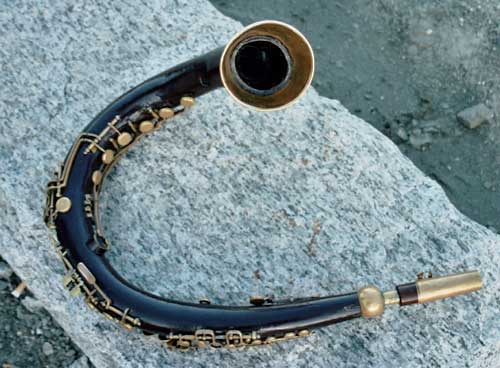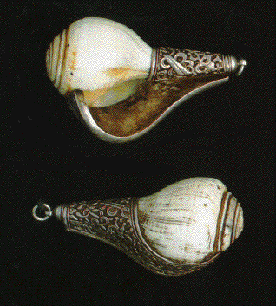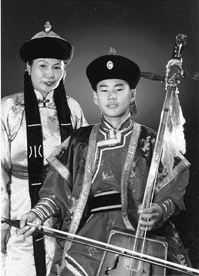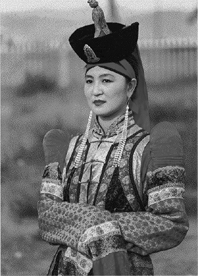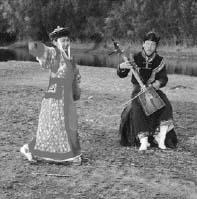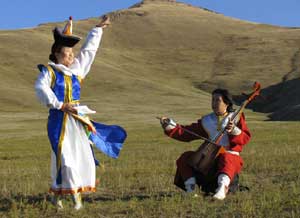Metallophones
In Javanese gamelan, the Metallophones usually play the melody part. Generally, the metallophones are a kind of "xylophone" with metal bars. The Metallophone family is basically divided into two groups:
Because of it's look, the wooden Gambang is sometimes considered as a metallophone.
The metal bars used in Saron and Gender are of different kinds. The Saron type has a thick and slightly curved bar. All of the bars are mounted over a single trough resonator. The mallets for Saron are made of hard wood or horn. The playing may be loud or soft. The Gender type has a thin and ribbed bar. Each bar is suspended over a tube resonator which is tuned to the pitch of that particular bar. The mallets for Gender have a head in the shape of disc which is covered by a detachable ring of padding, and the strokes are usually gentle.


a Saron metal bar a Gender metal bar
During playing, the player uses the right hand to grip the mallet, and uses the left hand to damp the metal bar. The player would not damp the bar immediately after it was struck, but as the next bar is being struck. To damp the sound, the player pinching the end of the metal bar between the thumb and forefinger.
Gongs

Most of the Javanese gamelan gongs are made of bronze, but sometimes they are made of iron. Although they are many different sizes of gong in Javanese gamelan, they are all in circular shape with a protruding knob at the center. During playing, the central knob is struck by a wooden mallet. Different kinds of mallet are used to struck on different types of gong.
There are two types of gongs in Javanese gamelan, refer to the way in which the gongs are supported:
Drums

Drums play an important part in a gamelan. The function of the drums is to play the rhythm part. In fact, the drummer is usually the leader of the whole gamelan.
In a gamelan, there are basically two different types of drums:
Gambang

The Gambang looks like a metallophone instrument, however, its bars are made of wood rather than bronze. There used to be two types of Gambang, a Gambang with bronze bars and a Gambang with wooden bars. Bronze Gambang used to be found in the gamelan but nowadays it is not used anymore. So, 'Gambang" is now referred to a wooden bar Gambang.
The wood used for the Gambang must be very hard. A type of wood known as berlian is normally used to make Gambang's bars. The wooden case to support these bars is like the saron's, but it is much deeper and with thinner sides. The purpose of this case is to act as a resonator. Each bar is secured on top of the case by pins. The bars are from about 58cm to 29cm. The length of the bar becomes shorter as the pitch rises. Each Gambang has approximately 19 to 20 bars.
The player need two mallets to play on a Gambang. The mallets have very long handles, approximately 35cm. They are made of buffalo horn, and are very thin and flexible. At the end of the handle, there is a wooden disc surrounded by a felt ring.
The Gambang usually play the fastest part in the gamelan.
Siter

A musician is playing a Siter

Siter is another instrument that play the elaborations of the melody. 'Siter" came from the Dutch word "citer," In English, as "zither." It is a plucked string instrument with an oblong box resonator. Usually a Siter has eleven or twelve pairs of unison strings.
Suling

The Suling is a simple bamboo flute. A notch is cut into the the side of the top end, and this top end is surrounded by a rattan of bamboo ring, leaving a small slit where the player will put his mouth on. Suling is the simplest and cheapest instrument in the gamelan.
There are basically two types of Sulings. A five finger-holes and a four finger-holes. Each for a different tuning system. Five finger-holes for pelog system and four for slendro system.
With its different color of sound, it provides one of the most expressive lines in the ensemble. It sometimes grouped with the Rebab and the voice, but its part is freer. Compared to other counter-melody instruments, its musical phrases is shorter and disjointed, rather than as a continuous line.
Saron Demung

![]() Pelog Demung
Pelog Demung ![]() (read this)
(read this)
![]() Slendro Demung
Slendro Demung ![]() (read this)
(read this)
Among the sarons, Saron Demung has the largest metal bars and produces the lowest sound. It's pitches are one octave lower than the Saron Barung. Like those of Saron Barung and Saron Panerus, in Saron Demung, the higher the pitch the smaller the bar. The measurements of the bars are approximately 35.5cm. long and 9 cm wide. However, the thickness of these bars are not as thick as those of Saron Panerus. All Saron family metal bars are in arch shape, in which, each bar has a flat bottom and a arch top. As the pitch rises, the arch of the bar also rises. The thickness (at the center) of the largest Demung bar is approximately 1cm. The mallets for Saron Demung are the largest among the mallets used to struck on Saron instruments. The structure of Demung's mallet are the same as those of the Saron Barung.
There are two types of Saron Demung, Pelog Demung and Slendro Demung. These two types of Demung are of different tuning system.
Saron Barung

![]() Pelog Barung
Pelog Barung ![]() (read this)
(read this)
![]() Slendro Barung
Slendro Barung ![]() (read this)
(read this)
Compared to Saron Demung and Saron Panerus, Saron Barung has the medium size metal bars. It's pitches are one octave lower than the Saron Panerus, and one octave higher than the Saron Demung. Like those of Saron Demung and Saron Panerus, in Saron Barung, the higher the pitch the smaller and thicker the bar.
The mallets for Saron Barung are the same as those of the Saron Demung, but smaller in size. It has a wooden handle and a wooden barrel-shaped head. The barrel-shaped head is detachable from the handle. This barrel-shaped head is secured to the wooden handle by a hole drilled about halfway through. Because of the thickness of the metal bars, the mallets used to struck on all Saron instruments has to be very hard. During playing, the player needs to struck strongly too.
There are two types of Saron Barung, Pelog Barung and Slendro Barung. These two types of Barung are of different tuning system.
Saron Panerus

![]() Pelog Panerus
Pelog Panerus ![]() (read this)
(read this)
![]() Slendro Panerus
Slendro Panerus ![]() (read this)
(read this)
Saron Panerus also known by its nickname Peking. It is the smallest saron in the Saron family. Compared to Saron Barung, Saron Panerus sound an octave higher in pitch.
The metal bars of Saron Panerus are smaller than those of the Saron Barung and Saron Demung. Like those of Saron Demung and Saron Barung, in Saron Panerus, the higher the pitch the smaller the bar. The measurements of the smallest Saron Panerus bar is approximately 18cm long by 4cm wide. However, these Panerus bars are thicker than those of the Saron Barung and Saron Demung. All Saron family metal bars are in arch shape, in which, each bar has a flat bottom and a arch top. As the pitch rises, the arch of the bar also rises. The thickness (at the center) of the smallest Panerus bar is approximately 2.5cm.
Because of the size of these smaller bars, the mallets of the Saron Panerus are smaller than those of the Saron Barung and Saron Demung. However, the thickness of Panerus metal bars required a harder mallet to struck on. A buffalo horn is usually used for the head of the mallet. This buffalo head helps to produce a bright and piercing sound .
There are two types of Saron Panerus, Pelog Panerus and Slendro Panerus. These two types of Panerus are of different tuning system.
Labels: majaradjasa











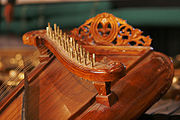
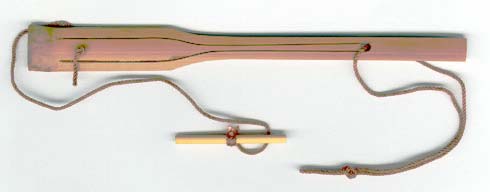 bamboo / wood jews harp
bamboo / wood jews harp